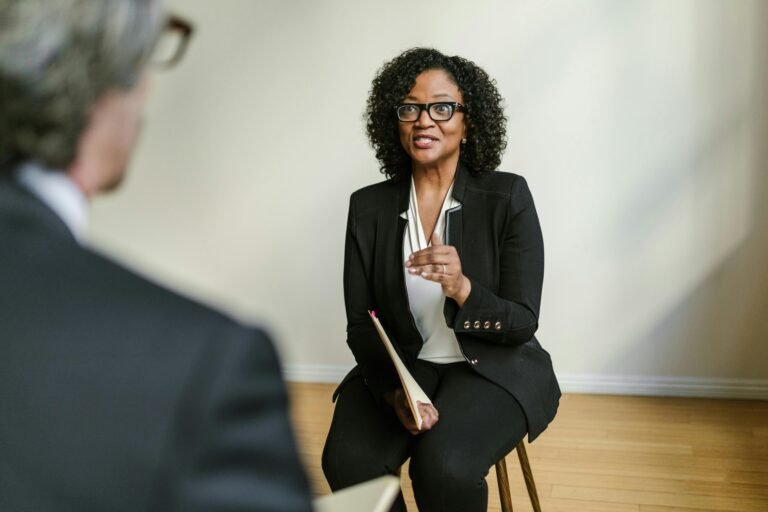The STAR method (Situation, Task, Action, Result) is a fantastic way to structure your responses to behavioral interview questions, especially for roles like school counseling, where interpersonal skills, problem-solving, and the ability to work with students in various emotional and academic situations are essential. The STAR framework allows you to answer questions clearly and concisely by focusing on specific examples from your past experience.
If you’re preparing for a school counselor job interview, using the STAR method can help you showcase your strengths, particularly in handling sensitive situations, building trust, and offering guidance to students. Below are 10 examples of how you can apply the STAR method to common interview questions for a school counselor position.
Interview Questions with Sample STAR Responses
Tell me about a time when you helped a student deal with a personal issue that was affecting their performance in school.
Sample Response:
- Situation: A high school student came to me feeling overwhelmed due to family issues at home, which were impacting their academic performance.
- Task: My task was to provide emotional support for the student and help them manage their feelings so they could improve their focus and performance in school.
- Action: I created a safe space where the student could express their feelings. We worked together to identify coping strategies, such as time management skills and stress-relief techniques. I also collaborated with the student’s teachers to offer flexible deadlines and ensure they received the support they needed in class.
- Result: Over time, the student’s emotional well-being improved, and they were able to manage their stress better. Their academic performance also improved, and they reported feeling more in control of their emotions and schoolwork. This situation demonstrated my ability to provide emotional support and collaborate with teachers to help students succeed.
Tell me about a time when you had to mediate a conflict between students.
Sample Response:
- Situation: Two middle school students were involved in an ongoing conflict that was starting to affect the classroom environment and their relationships with peers.
- Task: My task was to mediate the conflict between the students and help them reach a resolution in a way that restored a positive learning environment.
- Action: I first met with each student separately to understand their perspectives. Then, I brought both students together in a neutral setting, where I facilitated the discussion and encouraged open, respectful communication. I guided them to express their feelings and identify a mutual solution that addressed both their concerns.
- Result: The students were able to resolve their differences and agree on a plan to prevent future conflicts. Their relationship improved, and the classroom environment became more positive. This experience highlighted my conflict resolution skills and ability to mediate difficult situations.
Tell me about a time when you helped a student who was struggling academically and socially.
Sample Response:
- Situation: A freshman student was having trouble adjusting to high school, both academically and socially, and was showing signs of isolation and low self-esteem.
- Task: My task was to provide counseling and support to help the student improve their social interactions and academic performance.
- Action: I first met with the student to discuss their challenges and concerns. We worked together to identify strategies for managing academic stress, including creating a study schedule and setting achievable goals. I also encouraged the student to join extracurricular activities to build social connections. I maintained regular check-ins with the student to track their progress.
- Result: The student began to feel more confident both academically and socially. Their grades improved as they developed better study habits, and they made new friends through extracurricular activities. This situation demonstrated my ability to address both academic and social challenges and provide holistic support.
Tell me about a time when you had to support a student dealing with bullying.
Sample Response:
- Situation: A middle school student came to me reporting that they were being bullied by a group of peers, which was affecting their emotional health and school attendance.
- Task: My task was to provide support to the student and intervene in the bullying situation to ensure a safe and positive school environment.
- Action: I first ensured the student felt heard and validated. I provided emotional support through individual counseling and worked with the student to develop coping strategies for dealing with the bullying. I also took steps to involve the school administration, contacted the parents, and worked with the students involved to address the bullying behavior through restorative practices.
- Result: The bullying was successfully addressed, and the student felt safer and more supported at school. The student’s attendance improved, and their emotional well-being was restored. This experience demonstrated my commitment to creating a safe and supportive school environment for all students.
Tell me about a time when you had to work with parents to support a student’s well-being.
Sample Response:
- Situation: A student was struggling with anxiety, which was affecting their academic performance and behavior. The parents were unaware of the severity of the issue.
- Task: My task was to work with the student’s parents to ensure that they understood the situation and collaborated on a plan to support the student’s mental health and academic success.
- Action: I met with the parents to discuss the student’s struggles, providing them with information about anxiety and how it could impact the student’s performance. I worked with the parents to establish a plan, which included counseling services, teacher communication, and strategies to reduce stress at home. I also kept in close contact with the parents to monitor progress.
- Result: The student received the necessary support at home and school, leading to improved emotional well-being and better academic performance. The parents expressed gratitude for the collaborative approach, and the student felt more supported in all areas of their life. This situation demonstrated my ability to engage parents in a holistic approach to student well-being.
Tell me about a time when you had to help a student set academic or career goals.
Sample Response:
- Situation: A high school junior came to me feeling uncertain about their future and lacked direction regarding college and career choices.
- Task: My task was to help the student explore their academic interests and set realistic goals for their future career.
- Action: I conducted a series of career exploration sessions with the student, where we identified their strengths, interests, and values. I provided resources for researching potential career paths and helped the student create an action plan that included setting academic goals, exploring extracurricular opportunities, and researching colleges.
- Result: The student gained clarity and confidence in their future goals. They became more focused on their academic performance and started actively applying to colleges. This experience highlighted my ability to guide students in setting and achieving long-term academic and career goals.
Tell me about a time when you had to help a student with a mental health issue.
Sample Response:
- Situation: A student confided in me about experiencing severe depression and was finding it difficult to attend school and keep up with their assignments.
- Task: My task was to provide emotional support to the student and connect them with the appropriate mental health resources.
- Action: I listened to the student’s concerns with empathy and helped them identify strategies for managing their depression. I worked closely with the student’s parents and made referrals to mental health professionals for further support. I also collaborated with the student’s teachers to ensure they received accommodations, such as extended deadlines and a reduced workload, to help them manage their stress.
- Result: The student began receiving professional counseling and their mental health improved over time. They returned to school with a better ability to manage their depression, and their academic performance improved once they received the proper support. This situation highlighted my ability to support students dealing with mental health challenges and connect them to necessary resources.
Tell me about a time when you had to advocate for a student’s needs.
Sample Response:
- Situation: A student with a learning disability was not receiving the accommodations they needed to succeed in class, which was affecting their academic performance.
- Task: My task was to advocate for the student to ensure they received the proper support and accommodations.
- Action: I gathered data on the student’s needs and worked with the special education team and teachers to advocate for the accommodations the student required, such as extra time for tests and the use of assistive technology. I also worked with the student’s parents to ensure they were involved in the advocacy process.
- Result: The student received the necessary accommodations, which allowed them to perform better academically and feel more confident in their abilities. This experience demonstrated my commitment to advocating for students’ rights and ensuring they have the support they need to succeed.
Tell me about a time when you had to help a student navigate a difficult transition.
Sample Response:
- Situation: A student had recently moved to a new school and was struggling with the transition, feeling isolated and disconnected from their peers.
- Task: My task was to help the student adjust to the new school environment and build social connections.
- Action: I met with the student regularly to discuss their concerns and provided emotional support. I also facilitated opportunities for the student to meet new peers by encouraging participation in extracurricular activities and introducing them to others with similar interests.
- Result: The student began to feel more comfortable and eventually made new friends. Their social and emotional adjustment improved, and their academic performance also began to rise as they felt more integrated into the school community. This situation demonstrated my ability to guide students through transitions and help them feel supported in a new environment.
Tell me about a time when you had to collaborate with a team to support a student’s needs.
Sample Response:
- Situation: A student was experiencing academic and behavioral difficulties, and it was clear they needed a team-based approach to address their needs.
- Task: My task was to collaborate with teachers, parents, and other school staff to create a comprehensive support plan for the student.
- Action: I coordinated meetings with the student’s teachers, parents, and school psychologist to discuss the student’s strengths and challenges. We developed an individualized support plan that included behavioral strategies, academic accommodations, and counseling services. I also regularly checked in with the team to monitor the student’s progress.
- Result: The student’s behavior and academic performance improved as a result of the coordinated effort. The student felt more supported, and the collaboration between all parties helped create a holistic approach to meeting the student’s needs. This situation highlighted my ability to work as part of a team to support student success.
In Conclusion
Using the STAR method in your school counselor interview helps you to answer behavioral questions in a structured and compelling way. By reflecting on your past experiences and adapting them to the questions, you can effectively showcase your skills and demonstrate your ability to support students in various situations.
Good luck with your interview preparation and your pursuit of a rewarding school counselor position!
Related Posts
Guidance Counselor Resume Action Phrases
How to Use the STAR Method to Answer Interview Questions
How to Conduct a Self-Assessment to Identify Your Strengths and Weaknesses
Cover Letter Sample: High School Guidance Counselor









